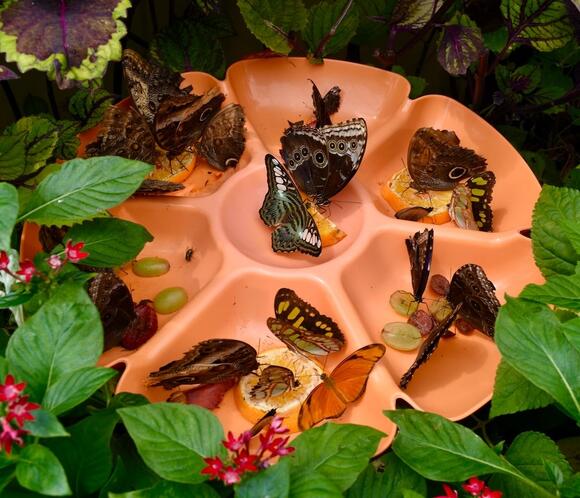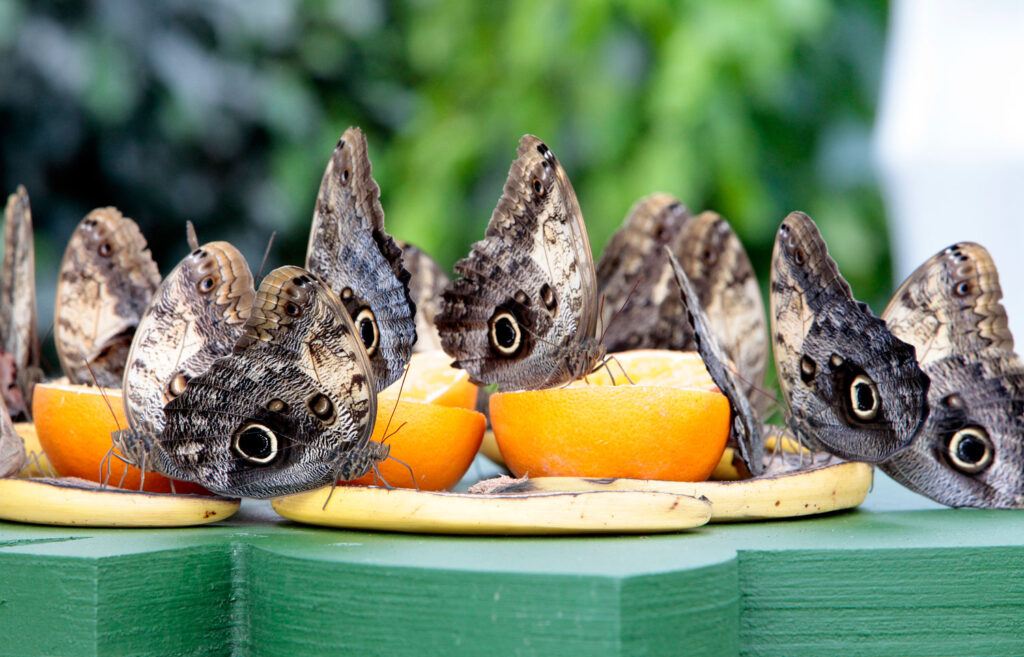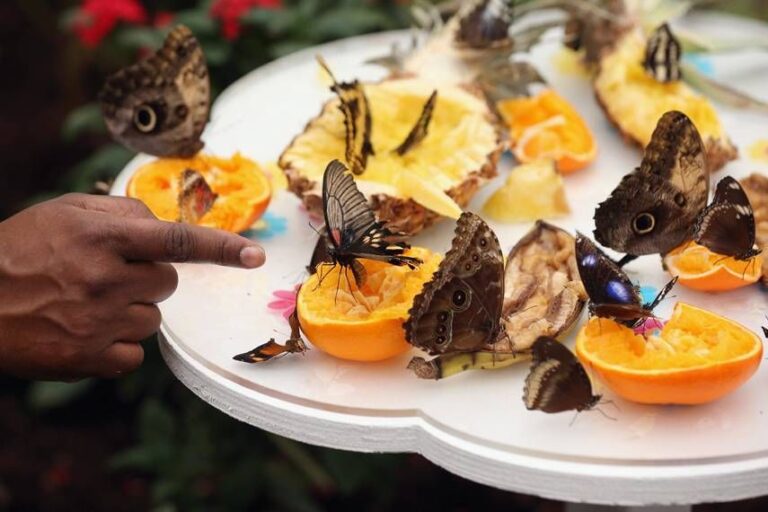Moths are not typically kept as pets like some other insects, so you don’t need to feed them in the same way you might feed a pet. However, if you have a specific reason for wanting to attract moths, such as for wildlife observation or scientific study, you can create a suitable environment to attract them.
To attract moths to your outdoor space for observation or scientific study, you can:
- Plant moth-friendly plants like jasmine and evening primrose.
- Use outdoor lights or UV lights to draw moths at night.
- Set up a moth trap with a light source and a white sheet.
- Maintain a natural garden environment without pesticides.
- Consider sugary baits or pheromone lures for specific species.
- Remember to attract moths responsibly, considering their ecological roles and potential impact.
What are the types of moths?
Moths are a diverse group of insects belonging to the order Lepidoptera, just like butterflies. They are incredibly diverse, with over 160,000 described species worldwide. In addition, moths can vary greatly in size, color, and shape, making them one of the most diverse insect orders.
There are various families and subfamilies within moths, each with its unique characteristics and adaptations.
Examples of diverse moth families include the hawkmoths (Sphingidae), silk moths (Saturniidae), and geometrid moths (Geometridae).
Variation in dietary preferences among different moth species

Moths exhibit a wide range of dietary preferences depending on their species and life stages.
Some moths are herbivorous, feeding on plant parts such as leaves, flowers, or nectar. For example, the hummingbird hawk moth feeds on nectar from flowers, much like hummingbirds.
Other moths are carnivorous during their larval stage, preying on other insects or even spiders. For instance, the famous tomato hornworm (Manduca quinquemaculata) is known for feeding on tomato plants during its larval stage.
Some moths have specialized diets and are associated with particular host plants. The monarch butterfly, although a butterfly, is an example of a Lepidopteran with a specific host plant, milkweed.
There are also moths that are scavengers, feeding on decaying organic matter, fungi, or even animal carcasses.
Dietary preferences can change throughout a moth’s life cycle, with caterpillars often having different food preferences than adult moths.
How do moths obtain nutrients in the wild?
The natural diet of moths varies widely based on their species and life stages.
Moth caterpillars (larval stage) often feed on plant leaves, stems, flowers, or fruits. They may be generalists, consuming a wide range of plant species, or specialists, feeding on specific
host plants.
Adult moths primarily feed on liquids, such as nectar from flowers. This behavior is essential for pollination, as moths are nocturnal pollinators for many plant species.
Some moths, especially those in the silk moth family (Saturniidae), do not feed as adults and rely on energy reserves built up during their caterpillar stage.
Certain moths, like the hummingbird hawkmoth, have adaptations for feeding on the wing, hovering in front of flowers to access nectar.
How moths obtain their nutrients from various sources:
Moths have specialized mouthparts adapted for their dietary preferences. For example, caterpillars often have chewing mouthparts to consume plant material, while adult moths may have long proboscises for sipping nectar.
During feeding, moths use their mouthparts to access and extract nutrients from their food source. Moths that feed on nectar play a crucial role in pollination by transferring pollen between flowers as they feed.
Caterpillars digest plant matter through a combination of mechanical breakdown (chewing) and enzymatic digestion. Some moths have co-evolved with specific plant species, developing adaptations that allow them to feed on or pollinate those plants effectively.
What foods are suitable for captive moths?
Feeding moths in captivity serves various purposes, including research, education, and conservation efforts.
Scientists often keep moths in captivity to study their life cycles, behaviors, and reproductive patterns, providing valuable insights into moth biology.
Educational institutions and nature enthusiasts may keep moths to observe their fascinating behaviors up close.
Conservation programs sometimes rear and release endangered moth species to boost their populations in the wild.
Captive feeding can also aid in the collection of moths for entomological collections and taxonomic studies.
Considerations for creating a suitable environment:
Enclosure setup: Moths should be kept in well-ventilated containers or enclosures with mesh or breathable materials to ensure proper airflow.
The enclosure should be appropriately sized to accommodate the number of moths and allow them to move freely.
Providing perches or vertical surfaces for moths to rest on is beneficial, as they often rest during the day.
Temperature and humidity requirements: Moths have specific temperature and humidity preferences based on their species. Research the requirements for the species you intend to keep.
Generally, most moths thrive in a temperature range between 70°F to 80°F (21°C to 27°C).
Humidity levels should be maintained based on the species’ natural habitat. Some moths require higher humidity, while others do well in drier conditions.
Types of foods suitable for captive moths:
| Feeding Options | Description |
| Nectar and Flower Blooms | Adult moths primarily feed on nectar from flowers, making fresh flowers an ideal food source. Offer a variety of nectar-rich flowers to cater to different moth species. |
| Sugary Solutions | In the absence of fresh flowers, provide moths with homemade sugary solutions. Mix sugar and water (usually around a 10% concentration) as a substitute for nectar. Change the solution regularly to prevent fermentation and microbial growth. |
| Fruit Options | Consider providing slices of ripe fruit as an additional food source for moths. Some species may be attracted to the sweet juices of fruits. |
Some moths are attracted to overripe fruits, especially those with fermenting odors. You can provide slices of ripe fruit like bananas or peaches as an alternative food source.
Specialized diets for specific moth species:
Some moth species have highly specialized diets. For example, the larvae of the monarch butterfly exclusively feed on milkweed.
Research the dietary preferences of the specific moth species you are keeping to ensure they receive appropriate food.
Frequency and quantity of feeding:
The frequency and quantity of feeding depend on the moth species, life stage, and environmental conditions. Adult moths typically feed at night and may consume nectar or sugary solutions as needed.
Moth caterpillars have voracious appetites and should be provided with fresh host plant material regularly.Monitor the moths and adjust feeding schedules based on their behavior and needs.
How can moths be attracted to observation?

Attracting moths for observation can be an intriguing project that requires setting up certain light sources, baits, and creating suitable environmental conditions to invite these nighttime insects to your observation spot.
Strategies for attracting moths to your location:
Moth-friendly plants: Moths are attracted to specific plants, especially those with fragrant, night-blooming flowers. Planting these species in your garden can help attract moths.
Examples of moth-attractive plants include moonflowers, evening primrose, honeysuckle, and jasmine.
Native plants are often the best choice, as they are well-suited to the local ecosystem and provide natural food sources for local moth species.
Light sources: Moths are drawn to light sources, especially at night. You can use outdoor lights strategically to attract moths for observation.
UV or black lights are particularly effective in attracting moths, as many species are sensitive to ultraviolet light. Install lights near moth-friendly plants to create a focal point for moths to gather.
Moth traps: Moth traps are specialized devices designed to attract and capture moths for observation.
Common types of moth traps include light traps, pheromone traps (used to attract specific species), and sugar or fruit bait traps.
A white sheet or cloth can also be used as a simple moth trap by illuminating it with a bright light source at night. Moths will be drawn to the light and land on the sheet for observation.
Maintaining an eco-friendly environment:
Avoiding pesticides: Pesticides, including insecticides and herbicides, can harm moths directly by killing them or indirectly by eliminating their food sources (plants or prey insects).
Choose natural or organic pest control methods that are less harmful to moths and other beneficial insects. Integrated pest management (IPM) is a sustainable approach to managing pests while minimizing harm to non-target species.
Supporting local biodiversity: A diverse ecosystem is more likely to attract a variety of moth species. Planting a diverse range of native plants in your garden can provide food and habitat for moths and their caterpillars.
Avoid monoculture landscapes, which are less attractive to wildlife. Reduce light pollution, which can disorient moths and other nocturnal creatures. Shield outdoor lights to direct light downward and use lower-intensity lighting when possible.
FAQ
How do I care for a moth?
Moths are typically not cared for as pets like some other insects. However, if you need to temporarily care for a wounded or sick moth, provide a safe, quiet, dark space and offer a small source of sugar water.
What do newborn moths eat?
Newly hatched moth larvae (caterpillars) typically feed on their host plant’s leaves, as their diet is species-specific. Ensure you know the species to provide the appropriate food.
Should I let my moth go?
If you’ve captured a moth for observation, it’s generally best to release it after a short period to ensure it can continue its natural behaviors and lifecycle.
Is it OK to hold a moth?
Moths are delicate, and handling them can harm their delicate wings or scales. It’s best to avoid touching them unless necessary.
Do moths like sugar?
Yes, many moth species are attracted to sugary substances, especially as adults. Sugar solutions or nectar can be used to attract and observe them.
How do you make moth food?
To attract moths, you can make a sugary solution by mixing sugar and water in a 10% concentration. Offering overripe fruits is another option for some species.
Final Words
In conclusion, understanding what to feed moths, whether in captivity or to attract them for observation, is a multifaceted endeavor. Moths, as a diverse group within the Lepidoptera order, exhibit a wide range of dietary preferences and behaviors based on their species and life stages.
While some moths feed on nectar, others may have specialized diets or even shift their preferences throughout their life cycles. Captive feeding of moths requires careful attention to factors such as enclosure setup, temperature, humidity, and suitable food sources, all tailored to the specific needs of the moths in question.
Moreover, attracting moths for observation can be an enriching experience, with strategies involving the use of moth-friendly plants, light sources, and traps.
However, it is imperative to maintain an eco-friendly environment by avoiding pesticides and fostering local biodiversity.

